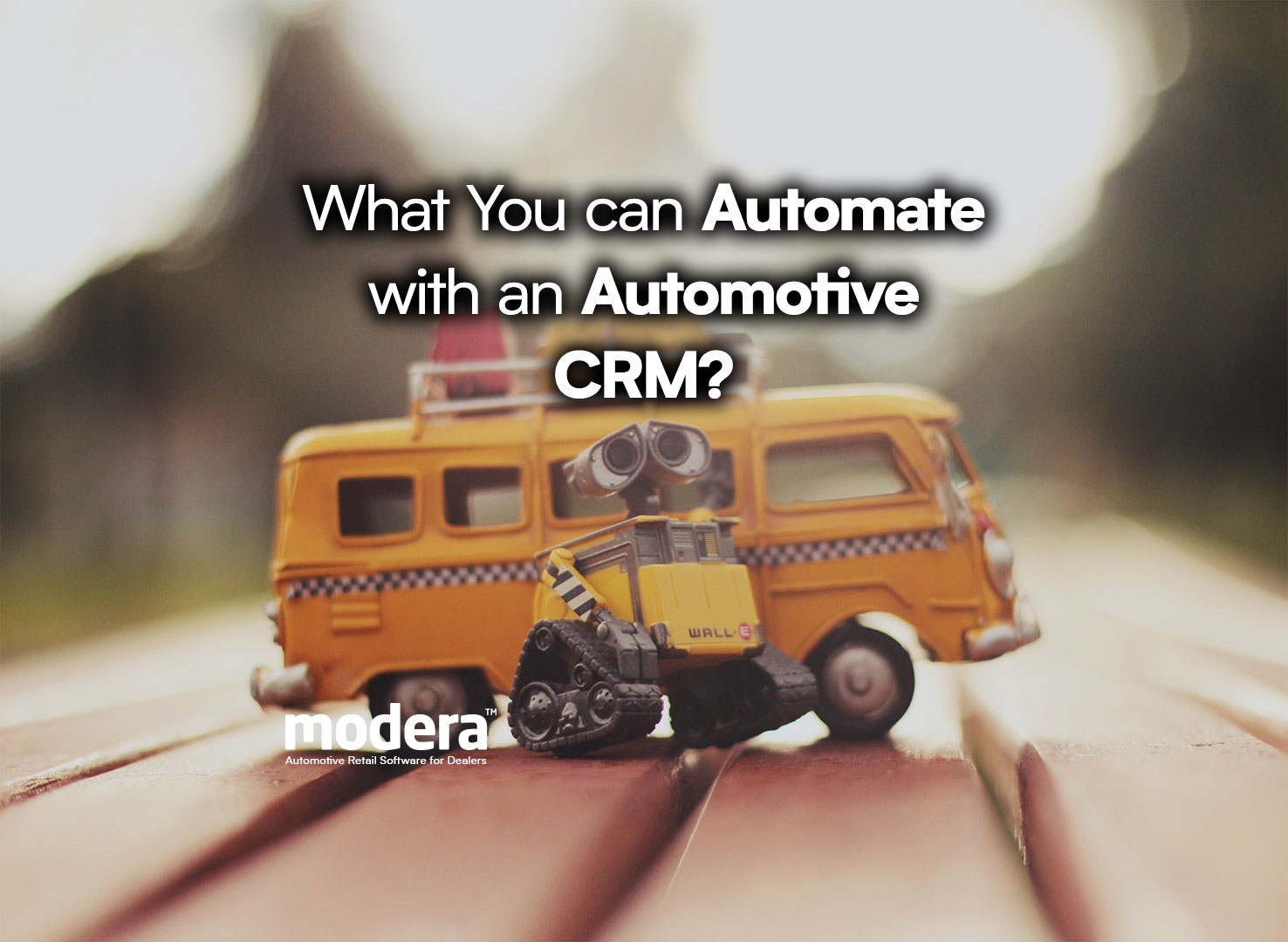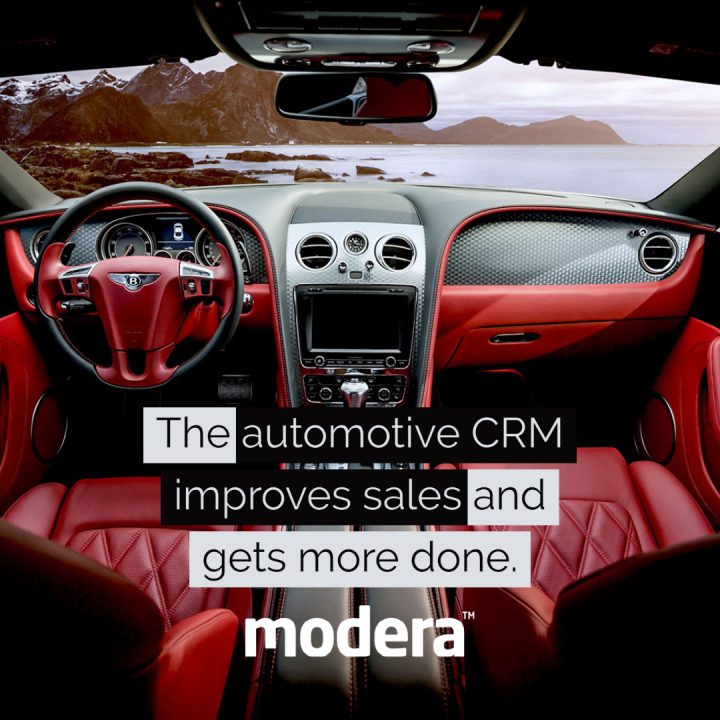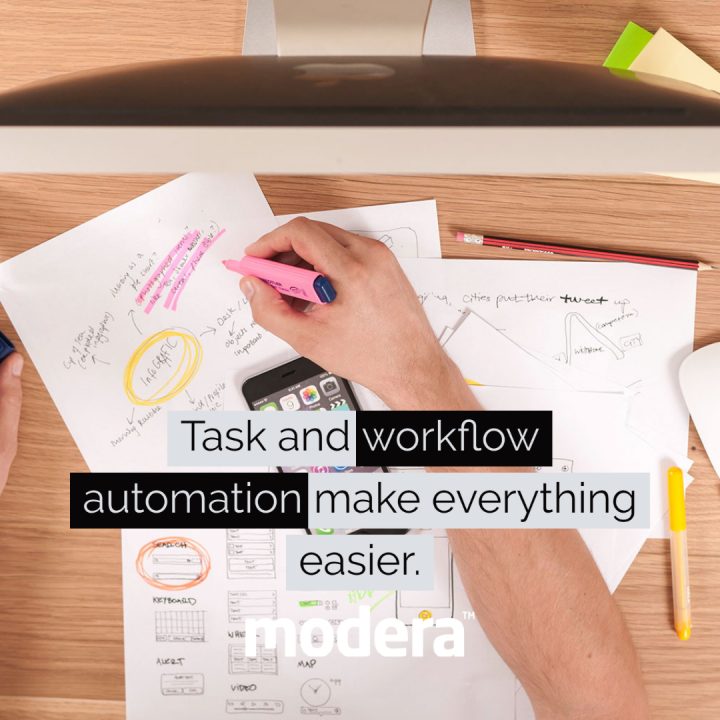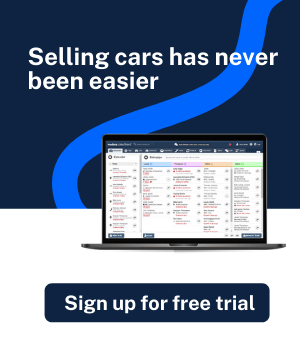If you are looking to get more profit from your dealership, then you have to be more efficient. One of the best productivity tools for dealership managers is an automotive CRM. With an automotive CRM, you can automate a number of tasks that allows you to get more done and improve your bottom line. Here, we will take a look at what exactly is an automotive CRM. From there, we’ll show you ten tasks that an automotive CRM can automate for your dealership operations.

What is automotive CRM?
An automotive CRM is a customer relationship management that allows you to better organize and understand the data that comes from your leads and existing customers. All of this information is presented on a dashboard that allows you to see just about every aspect of your operations.
Here’s a look at some of the data that you will find in an automotive CRM:
- Ad media placement
- Ad spending
- Current leads
- Current sales
- Performance of sales reps
- Conversation rate for specific dealership services
- ROI on specific ad executions
- Conversation rate by customer demographics
Of course, there are a number of other data points that will be at your fingertips. With an automotive CRM system, you will be able to organize this information to help you reach your dealership sales goals.
What can you automate with an automotive CRM?
Now that you have some familiarity with an automotive CRM, let’s take a look at all the amazing ways that this platform can automate your dealership operations. Here, we will list the top 12 ways an automotive CRM can better automate your workflow.
1. Daily workflow
As a dealership manager or owner, you have a lot of tasks to juggle. Chances are that you have a giant whiteboard where you try to best organize what needs to be done in a day. While a whiteboard is great for giving you an overview of your dealership managerial tasks, an automotive CRM can help you move around all the information on the platform to give you more options.
For instance, let’s say that you have a big Memorial Weekend sales event coming up. Chances are, you will have to deviate from your usual routine to handle the increased foot traffic to your dealership. With an automotive CRM, you can better organize what needs to be done for that crucial sales weekend.
How you can implement this:
- You can easily organize and see what needs to be done in a day.
- You can make quick adjustments to your schedule to accommodate the unexpected.
- You can easily set up special workflows for specific projects or events such as holiday sales.

You can better organize sales events with an automotive CRM.
Check out our automotive CRM tool for free.
2. Lead assignment
Your leads are gold. You’ve spent lots of time and money to get those leads in your dealership. Now it’s time to convert them into sales. However, you have to make sure that your leads go to the right salesperson or that lead will become worthless. With an automotive CRM, you can easily see which salesperson has the best track record for certain types of leads.
For instance, you may have one salesperson that knows how to close SUV sales to women versus everyone else on your team. Perhaps you have a salesperson who is really good at handling sales to first-time buyers under the age of 30. Your automotive CRM will help you put your leads into the right hands. When you are dealing with dozens of leads per day, this automated task can come in handy.
How you can implement this with automotive CRM:
- You can quickly assign leads to the right sales associates.
- You can track which sales associate is most successful with certain types of leads.
- You can track the performance of each lead.
3. Marketing
Marketing can make or break a dealership. Therefore, it is important for the dealership manager to know where to find the right marketing and advertising opportunities that bring in the best ROI. With an automotive CRM, you will be able to track the performance of all marketing channels based on cost per lead and cost per sale.
For instance, you can see which Facebook ads or YouTube ads are giving you the best bang for your buck. You can also see all the split testing results on ad executions in one screen. This allows you to quickly shift your marketing dollars towards the ad executions that are delivering the best results.
How you can implement this:
- You can quickly track media executions, ROI, and cost per lead.
- You can place more of your ad spending on the best-performing ad executions.
- You can quickly kill the ads that are not working or losing money.

Get the best ROI with right marketing and advertising.
4. Streamlining tasks
A dealership has lots of moving parts, from the sales department to the service center and the marketing team, you need to make sure that you don’t have people sitting around not getting anything done. With an automotive CRM, you can quickly see who is working on what. This allows you to quickly maximize the efficiency of every employee.
Let’s take the marketing department as an example. Let’s say that you have a marketing employee working on Facebook, Twitter, Youtube, and Instagram posts. The person works 10 hours a week for all the weekly content for the dealership’s social media accounts. That’s 40 hours a month. However, that same social media may be able to complete a month’s work of social media posts by simply working on all the posts in the first week of the month for 20 hours. That frees up 20 extra hours of that employee’s time to work on something else.
How you can implement this with automotive CRM:
- You can eliminate redundant tasks.
- You can place the right people on the right tasks.
- You can find opportunities to get certain tasks completed faster.
Find out how you can improve the tradein process with our tool.
5. Customer Relationship Management
When it comes to getting sales, there is nothing like getting repeat business from existing customers. After all, repeat business is a lot less expensive than trying to get a new customer. That’s why customer relationship management (CRM) is so important. With an automotive CRM, you can quickly identify your existing customers and target specific communications to convert more sales.
Here’s an example. Let’s say one of your top customers is coming up on the four-year anniversary of buying a $60,000 SUV from your dealership. You can contact that person and invite them to test drive a brand new version of the SUV that they already own. From there, you will be well-positioned to close a sale or lease with just one phone call.
How you can implement this:
- You can target likely repeat customers.
- You can find out which customer’s vehicles need servicing.
- You can identify high-value VIP customers.
6. List Segmentation
Chances are that your dealership has a list of hundreds or even thousands of leads and existing customers. The thing is, that big pile of customers and leads can be more useful if you can segment them into helpful lists. With an automotive CRM, you can quickly segment the list in any way that you please. This will allow you to better organize your leads and customers for marketing and sale purposes.
For instance, you can separate your leads from high-income zip codes from lower-income zip codes. You can also create a list of existing customers who drive SUVs versus those who lease sedans. With these segmented lists, you will be better able to target specific vehicles to specific customers.
How you can implement this:
- You can quickly create lists of customers by income, demographics, and vehicle preference.
- You can create lead lists for each sales associate.
- You can segment lists for targeted email/text campaigns.
7. Lead Scoring with automotive CRM
Your dealership is going to have a number of leads. It is going to be important to prioritize the leads that are likely to convert to sales. With an automotive CRM, you will be able to find the “golden” leads by applying a set of scores. You can score leads by a number of parameters such as income level, interest level, source of lead, and vehicle interest.
Here’s an example of how lead scoring can work for your dealership: You can take the top leads and give them to your top-performing sales associates. You can let these top sales associates know that these are high-scoring leads that should get top priority. The lowest scoring leads can be given to newer sales associates and used for training purposes:
How you can implement this:
- Score all leads by a given set of parameters.
- Give the highest priority to top-scoring leads.
- Place a lower priority on the lower scoring leads.

Track salespeople’s performance for certain types of leads.
8. Upselling and Cross-Selling
One of the biggest chunks of your business is going to come from upselling and cross-selling. With an automotive CRM, you can better find upselling and cross-selling opportunities based on customer data and the performance of upsells and cross-sells at your dealership.
Here’s an example of how to automate your upselling and cross-selling – Let’s say that your automotive CRM data shows that upselling extended warranties on a certain model has a higher conversion rate. You can instruct your sales team to offer an extended warranty on that model. Now let’s say that performance tires are a high converting upsell on another model. In this case, you can inform your sales team to push the performance tires on that particular model.
How you can implement this:
- Instruct sales associates on high converting upsells and cross-sells on specific models.
- Create a list of upsells and cross-sells by conversion rates.
- Offer better prices on lower converting cross-sells and upsells.
9. Track Sales Rep Performance
It’s important to know how your sales team is doing. While it is easy to see who is closing what sales with a whiteboard, an automotive CRM is able to give your more specific information about the performance of each sales associate. This allows you to assign your sales team to the right lead which can lead to a better conversion rate.
For example, let’s say that you have a sales associate with an average conversion rate. Upon further investigation of the sales associate’s performance via the automotive CRM, you discover that this sales associate is able to close on truck sales at a higher rate than SUV sales. At this point, you can assign this particular sales associate exclusively to your truck leads.
How you can implement this:
- Easy track the sales performance of your team by vehicle sales.
- Identify sales associates with higher conversion rates by vehicles.
- Distribute the right leads to the right sales associates based on vehicle sales/lease performance.
10. Goal Setting
It’s important to set goals for your dealership and your team. Goals not only give you focus, but they also allow your sales team to know what needs to be done. With an automotive CRM, you can set better goals for your sales team and for the dealership as a whole.
Here’s how you can automate goal setting with an automotive CRM – look at the current performance of a sales associate. From there, you can set a goal that is specific for that salesperson. You can set the goal based on the sales associate’s past performance and the overall sales goal of the dealership. By customizing goals automatically, your dealership is more likely to reach your overall goal.
How you can implement this with automotive CRM:
- Set goals for each sales associate.
- Get a live snapshot look at how your dealership is performing compared to your goals.
- Make adjustments to ensure that the dealership is able to reach its goals.

The automotive CRM gets more done and improves sales.
11. Create Scheduling for Service Center Business
The service center is a bigger part of your dealership these days. Therefore, you need to make sure that you have a steady stream of business coming in for everything from regular service to repair work. Using all the valuable data in your automotive CRM, you can be able to identify the customers who are more likely to require service and repair visits.
Here’s an example of how you can automate your automotive CRM for service and repair scheduling. You can enter the interval for recommended services such as oil changes, multi-point inspections, and brake pad resurfacing. From there, you can estimate which customers would need a particular service by the age of their vehicle. An email and text campaign can be created from these segmented lists to get those customers into the service center.
How you can implement this:
- Discover which existing customers will need service or repair work.
- Create segmented lists based on specific service and repair work.
- Use those segmented lists to create customized email and text campaigns.
12. Determine Which Models to Promote
Chances are that your dealership has a number of different models to promote. However, which models are likely to lead to the best leads and sales? With your automotive CRM, you can better decide which vehicles to promote. This can help you move certain vehicles off of your inventory faster.
Here’s an example by deciding which vehicles to promote. You can create a split test social media campaign of different vehicles. From there, you can see which vehicles are getting the best engagement rates. From there, you can dedicate more of your big media ad spend (TV, radio, and print) to the vehicles that have the best response.
How you can implement this:
- Split test vehicles in social media campaigns.
- Determine which vehicles get the best social media engagement and select those vehicles for major campaigns.
- Use the most popular vehicles as a “hero” vehicle for your dealership inventory ads.

Task and workflow automation make everything easier.
Recap of the 12 ways an automotive CRM can automate your dealership business
Here is a recap of the 12 ways that an automotive CRM can not only automate your business but improve your operations:
- Daily workflow
- Lead assignment
- Marketing
- Streamlining tasks
- Customer relationship management
- List segmentation
- Lead scoring
- Upselling and cross-selling
- Track sales rep performance
- Goal setting
- Create scheduling for service center business
- Determine which models to promote
Getting started with an automotive CRM
With an automotive CRM, you can get more done than you’d expect. Not only that, you can automate many of the tasks that take up so much of your time during the day. By automating more tasks, you can get more done. Since an automotive CRM can be so robust, it is a good idea to choose a platform that is easy to use and offers lots of support. With the right automotive CRM, you can get more done at your dealership and potentially experience improved sales.

